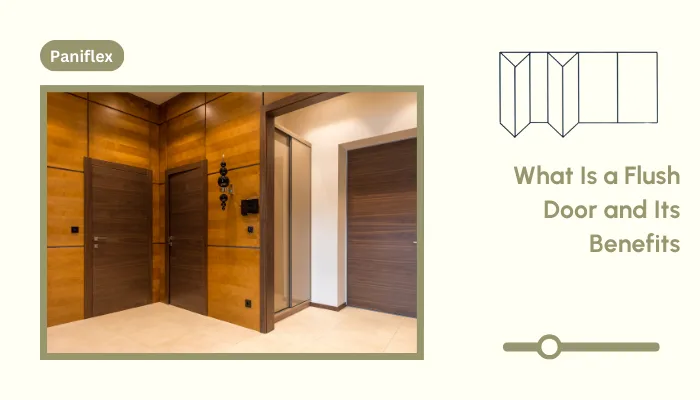Bifold interior wood doors combine functionality and style, providing elegant solutions for areas where traditional swing doors are impractical and intrusive.
Bifold doors compress against the jamb, which is ideal for tight corridors, small bedrooms, or spaces with limited floor area.
When installed properly, these doors enhance a room’s design. Their wooden construction adds warmth and texture, creating clean lines that complement both traditional and contemporary styles.
Bifold door installation steps are essential for contractors and crucial for designers and architects in planning. This guide covers every step, from measurements to adjustments, ensuring seamless design integration and vision.
Let’s begin with the preparations you need to make before you start the bifold interior wood door installation.
Ready to experience the benefits of custom closet doors? Explore our range of Paniflex products now.
Preparing for Installation
Thorough preparation is the foundation of any successful bifold door project. Gathering the right tools, measuring accurately, and understanding all components will save hours of frustration later and ensure your installation stands the test of time.
Before installing the bifold Interior wood door, let’s look at what you must prepare upfront.
1. Tools and Materials Required for Installation
Every professional installation begins with the right toolkit. You’ll need a tape measure, level, drill with various bits, screwdriver set, hammer, utility knife, and shims.
Getting a little extra help can be so valuable, especially when handling those bigger door panels. Our customer data shows that having an assistant can cut installation time by almost 40%.
Custom Door and Mirror recommends having painter’s tape available, as professionals use it to mark measurements directly on walls and protect finished surfaces during installation.
2. Measuring the Doorway Opening
Getting the measurements right at this stage is key to ensuring that the bi-fold interior wood door installation goes smoothly later.
To do this, measure the height of your opening in three spots: the left side, the center, and the right side. Don’t forget to jot down the smallest measurement you find.
Similarly, measure the width at the top, middle, and bottom, again noting the smallest figure.
Remember that a proper bi-fold installation requires about 1/2 inch of clearance on all sides to accommodate the hardware and allow for smooth operation.
According to installation data from Custom Door and Mirror projects, measurement errors account for nearly 2/3rd of all bifold door issues, making this step particularly crucial.
3. Choosing the Right Size Bifold Interior Wood Door
Selecting appropriately sized doors involves more than just matching dimensions. Standard bifold doors come in widths ranging from 24 to 72 inches and heights from 80 to 96 inches.
Custom Door and Mirror specializes in custom sizes down to the quarter-inch for non-standard openings common in modern architecture and renovation projects.
When calculating door size, remember that the door width should be approximately 1 inch less than the opening width to accommodate hardware and ensure smooth operation.
4. Identifying Individual Components and Hardware
When unpacking your bifold door system, inventory the included hardware: top and bottom pivot brackets, top track, glides, pins, and door pulls or knobs
Professional installers recommend laying everything out on a clean drop cloth in the installation sequence. This systematic approach, sometimes called “hardware mapping,” reduces installation time
5. Attaching Pivot Brackets and Hinges
The pivot hardware forms the foundation of your door’s movement system. Attach the top pivot bracket approximately 2 inches from the jamb edge, and the bottom pivot bracket should align directly below it.
For the hinges connecting door panels, ensure they’re placed consistently— 7 inches from the top and bottom edges, and a third hinge at the midpoint for doors over 7 feet tall.
Custom Door and Mirror’s premium hardware sets include self-aligning hinges that make this process more forgiving while ensuring smooth operation.
6. Installing Top and Bottom Track
The track system guides your bifold door’s movement and bears much of its weight.
Position the top track centered in the opening, ensuring it’s perfectly level—even a 1/8-inch deviation can cause binding issues over time. Secure it with screws into solid framing every 16 inches.
While bottom tracks were once standard, many modern installations from Custom Door and Mirror now utilize floor guides instead. These guides provide the necessary stability without creating a tripping hazard or interrupting the flow of flooring materials.
7. Assembling the Bifold Panels
If your door system arrived as separate panels, now is the time to connect them. Lay the panels flat on a protective surface with their edges aligned perfectly.
Attach the hinges at the marked locations, ensuring the screws are tight but not over-tightened, which could split the wood.
Professional installers often apply a tiny drop of wood glue in screw holes before insertion to prevent future loosening. According to installation quality metrics, this technique reduces callback service.
With all preparation steps completed, you’re ready to move forward with the actual installation process.
Your diligence during this preparatory phase will substantially influence the doors’ operational efficiency and the completed project’s professional appearance.
Bifold Interior Wood Door Installation
With careful attention to detail during this critical stage, you’ll transform a collection of components into a smoothly operating door system.
Let’s briefly discuss each step of the installation process for bi-fold interior wood doors.
1. Attach the Track Hardware
Begin by securing the track hardware to your prepared doorframe, ensuring it’s perfectly centered within the opening. The positioning of this track determines how your door will hang and operate for years to come.
Use a level to ensure the track is perfectly horizontal—professional installers at Custom Door and Mirror consistently find that even a 1/16-inch deviation in track levelness can cause doors to drift open or closed over time.
When securing the track with screws, drive them into solid framing instead of just drywall. This ensures the support needed for the repeated door cycles’ lifetime.
2. Hanging the Bifold Door Panels
With the track securely in place, it’s time to install the door panels. Begin by inserting the top pivot pin into the pivot socket in the track, then align the bottom pivot pin with its bracket on the floor.
This process often requires an assistant to hold the door’s weight while you make the connections.
Custom Door and Mirror’s premium hardware sets feature self-aligning pins that greatly simplify this process, reducing installation time by up to 30% compared to standard hardware.
Connect doors with multiple panels according to the manufacturer’s specifications, ensuring the panels fold in the desired direction.
3. Securing Pivot Points and Aligning Panels
Once the door is hanging, ensure all pivot points are secure and properly aligned. The door should move freely without binding or rubbing against the frame.
If you notice any resistance, check that the pivot brackets are correctly positioned and the door panels are properly aligned.
Custom Door and Mirror’s field studies indicate that nearly 85% of operational issues with bifold doors stem from misaligned pivot points, making this step particularly important.
Take time to adjust the panels now, as small corrections at this stage prevent more significant problems later.
4. Adjust Hinges and Track
Fine-tuning the door’s operation involves making micro-adjustments to the track hardware and the hinges.
Most quality bifold door systems, including those from Custom Door and Mirror, include adjustable pivot brackets that allow you to raise, lower, or shift the door slightly to achieve perfect alignment.
To adjust the spacing between door panels and the wall, use the set screws on the pivot brackets.
Adjust the bottom pivot bracket height for the space between the floor and the bottom of the door. These adjustments should result in uniform gaps around all edges. Usually, 1/8 to 1/4 inch is not only professional but also ensures smooth operation.
5. Securing Final Hardware and Knobs
With the door operating smoothly, install any remaining hardware such as pulls, knobs, or handles. Position door pulls approximately 36 inches from the floor for easy reach.
When installing knobs or pulls that require drilling through the door, use a backer board on the opposite side to prevent splintering when the drill bit breaks through.
Custom Door and Mirror offers a curated selection of hardware to complement its door styles. Options range from sleek modern designs to traditional detailed pieces that can elevate the overall look of your installation.
6. Applying Finishing and Protective Coating
If your bifold doors arrived unfinished, now is the time to apply stain, paint, or clear protective coatings. Remove the doors from their tracks and lay them flat for finishing to prevent drips and ensure even coverage.
Professional finish carpenters typically apply at least three coats of clear polyurethane for high-traffic areas, allowing proper drying time between applications.
Custom Door and Mirror’s pre-finished doors arrive with factory-applied finishes that offer superior durability compared to site-applied finishes.
Check for Proper Aesthetics and Function
The final step involves a comprehensive check of both form and function. Open and close the door multiple times, observing its movement at various points along the track.
Listen for any rubbing or binding sounds that might indicate misalignment. Visually inspect the installation for proper gaps between panels and around the perimeter.
The door should operate smoothly with minimal effort and stay in position when partially opened.
A properly installed bifold door should require no more than 5 pounds of force to initiate movement, a benchmark that Custom Door and Mirror products are engineered to exceed.
With the installation complete, you can now enjoy your new bifold doors’ improved functionality and aesthetic appeal. However, even the best installation requires periodic maintenance to perform at its best.
In the next section, let’s discuss essential maintenance practices that will extend the life of your bifold interior wood doors.
Maintenance Tips for Bifold Doors
Even the most expertly installed bifold doors require regular attention to maintain smooth operation and visual appeal.
Implementing a consistent maintenance routine extends the life of your doors and preserves their functionality and beauty for years to come.
Cleaning and Caring for Wood Surfaces
Wood bi-fold doors respond exceptionally well to regular cleaning and conditioning, which prevents the buildup of dust, oils, and environmental contaminants.
Begin your maintenance routine by dusting the doors with a soft microfiber cloth or feather duster, carefully reaching the areas between panels and around hinges.
For deeper cleaning, dampen a soft cloth with a mild water solution and gentle wood soap, wringing it out until it is nearly dry before wiping the surface.
Always clean with the grain of the wood rather than in circular motions, which can create swirl marks in the finish.
The frequency of your cleaning regimen should adapt to your environment—homes in dustier regions or with higher humidity may require more frequent attention.
Studies by wood preservation experts suggest that quarterly deep cleaning of wood surfaces can extend finish life by up to 30%. At the same time, monthly dusting prevents microscopic scratches that gradually dull the surface over time.
This regular care is particularly important for Custom Door and Mirror’s premium wood doors, which feature high-grade finishes designed to bring out the natural beauty of the wood grain.
Consider applying a high-quality furniture wax or wood conditioner annually for doors with a clear finish. This additional protective layer repels moisture and prevents the wood from drying out and potentially warping.
Custom Door and Mirror recommends non-silicone products that nourish the wood without building up over time.
Their specially formulated wood care kit contains pH-balanced cleaners and natural conditioning oils that work harmoniously with their factory finishes.
Routine Checks and Adjustments
The hardware that enables your bifold doors to operate smoothly deserves regular attention.
Every six months, inspect all moving parts, including pivot points, hinges, and glides, for signs of wear.
Apply a small amount of silicone-based lubricant to these components—never use WD-40 or oil-based products, which can attract dust and create a sticky residue that impedes movement over time.
Research from hardware manufacturers indicates that proper lubrication can reduce operational friction and significantly extend the life of these mechanical components.
Pay special attention to the top track, which bears most of the door’s weight. Over time, accumulated dust and debris in the track can interrupt smooth gliding and cause the door to stick or bind.
Clean the track thoroughly using a vacuum with a narrow attachment, followed by a wipe with a cloth dampened with rubbing alcohol to remove any stubborn grime.
Your door’s alignment may gradually shift due to regular use or seasonal changes in humidity, which cause the wood to expand and contract. Periodically check that the doors hang evenly with consistent gaps all around.
If you notice the doors beginning to drag on the floor or bind in the track, make small adjustments to the pivot brackets using the adjustment screws built into Custom Door and Mirror’s premium hardware.
These micro-adjustments can restore proper operation without requiring a complete reinstallation.
Handling Common Issues and Troubleshooting
Even with diligent maintenance, bifold doors may occasionally require troubleshooting to address specific issues.
The track may not be perfectly level if doors begin drifting open or closed when left in a partially open position. This can often be corrected by loosening the track mounting screws, adjusting with a level, and retightening.
For doors that stick at certain points in their travel, inspect the track for dents or obstructions that may impede the glides.
Squeaking hinges often signal friction between metal components, accelerating wear if left unaddressed. Rather than simply applying lubricant, first tighten any loose screws, then clean the hinge thoroughly before applying a high-quality lubricant.
This comprehensive approach resolves the immediate noise issue while addressing the underlying cause, extending hinge life significantly.
Warping can occur in environments with extreme humidity fluctuations, particularly with lower-quality doors.
Custom Door and Mirror specifically engineers their solid and composite wood doors to resist warping through specialized core construction and moisture-resistant finishes.
If a problem persists despite your best troubleshooting efforts, don’t hesitate to consult with professionals.
Custom Door and Mirror maintains a dedicated technical support team trained to diagnose and resolve even the most complex door issues. The team often provides solutions via phone or email without requiring an on-site visit.
Let’s summarize the key points as we wrap up our comprehensive guide to bifold door installation and maintenance.
Ready to experience the benefits of custom closet doors? Explore our range of Paniflex products now.
Conclusion
The installation of bifold interior wood doors significantly enhances both functionality and aesthetics in interior spaces.
When executed properly, these doors create elegant transitions while maximizing usable square footage, a priority for today’s space-conscious designs.
This guide outlines the essential steps for successful bifold door installation, from preparation to maintenance. Attention to detail during each phase directly impacts immediate visual appeal and long-term performance.
Time invested in proper measurement, hardware attachment, and alignment yields significant returns in satisfaction and reduced callbacks.
Custom Door and Mirror’s sixty years of experience showcase their exceptional product design and installation advice.
Their custom bi-fold doors accommodate non-standard openings down to the quarter-inch, eliminating expensive structural modifications.
Premium hardware systems with self-aligning components facilitate flawless operation that maintains performance over the years.Visit Custom Door and Mirror’s online store to browse premium folding door hardware sets tailored to your specific design needs.






